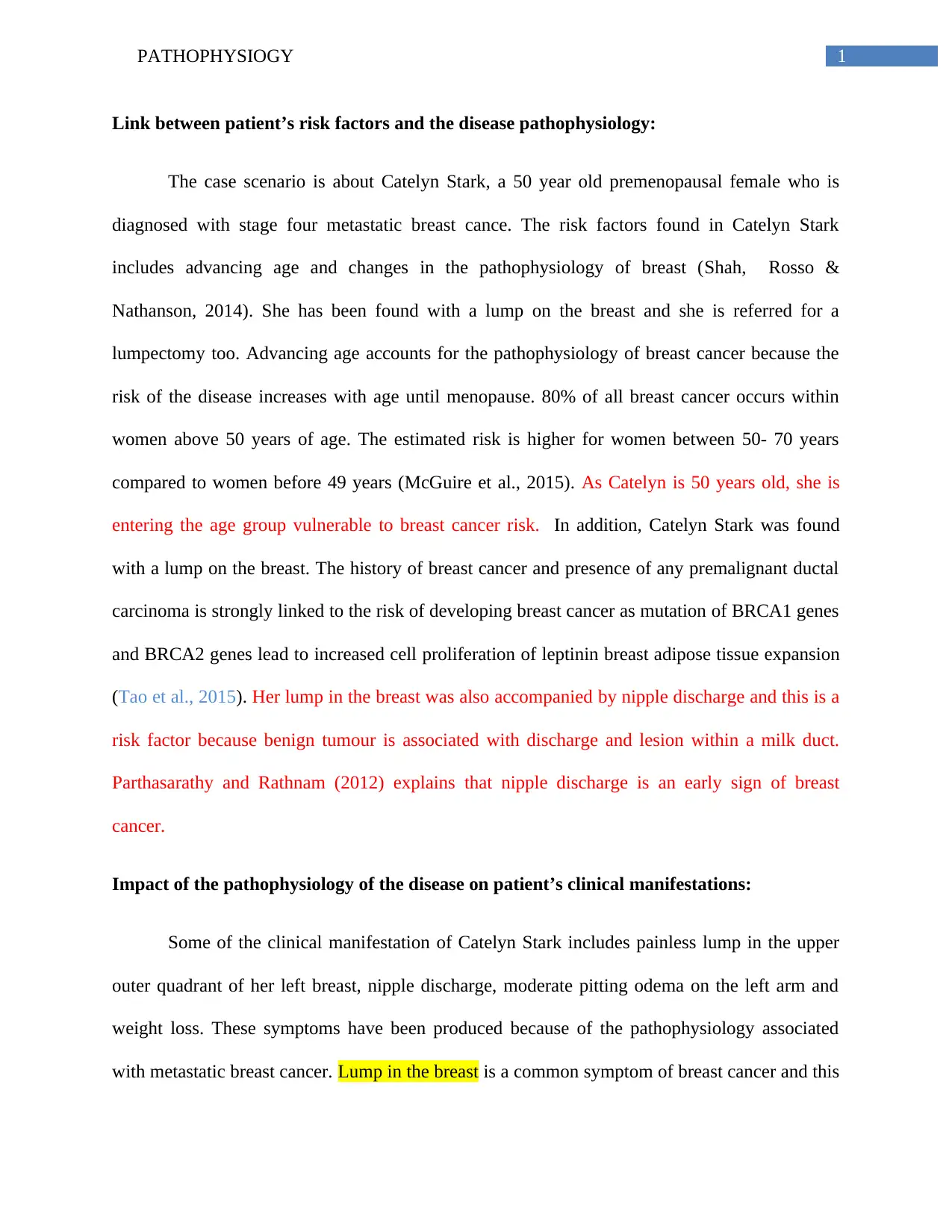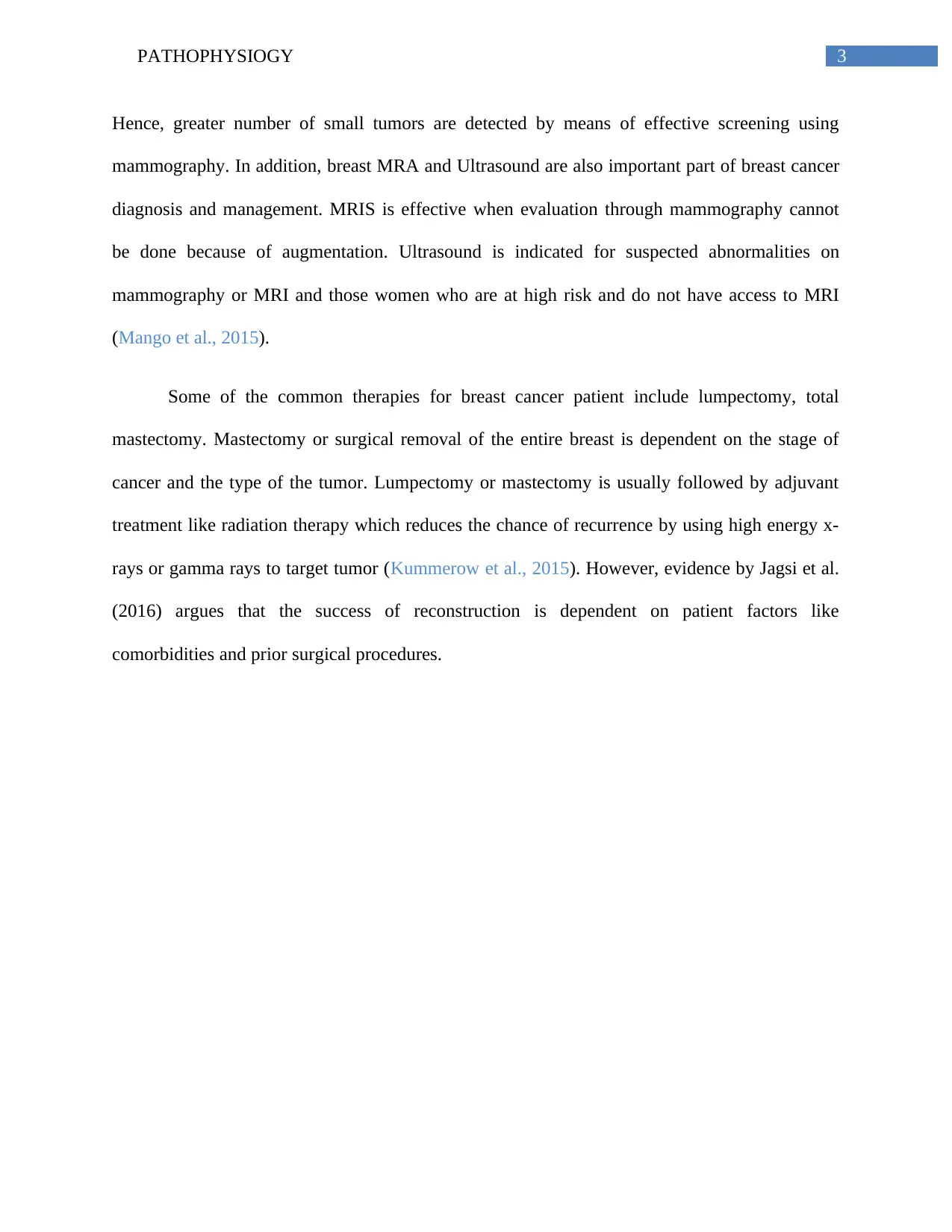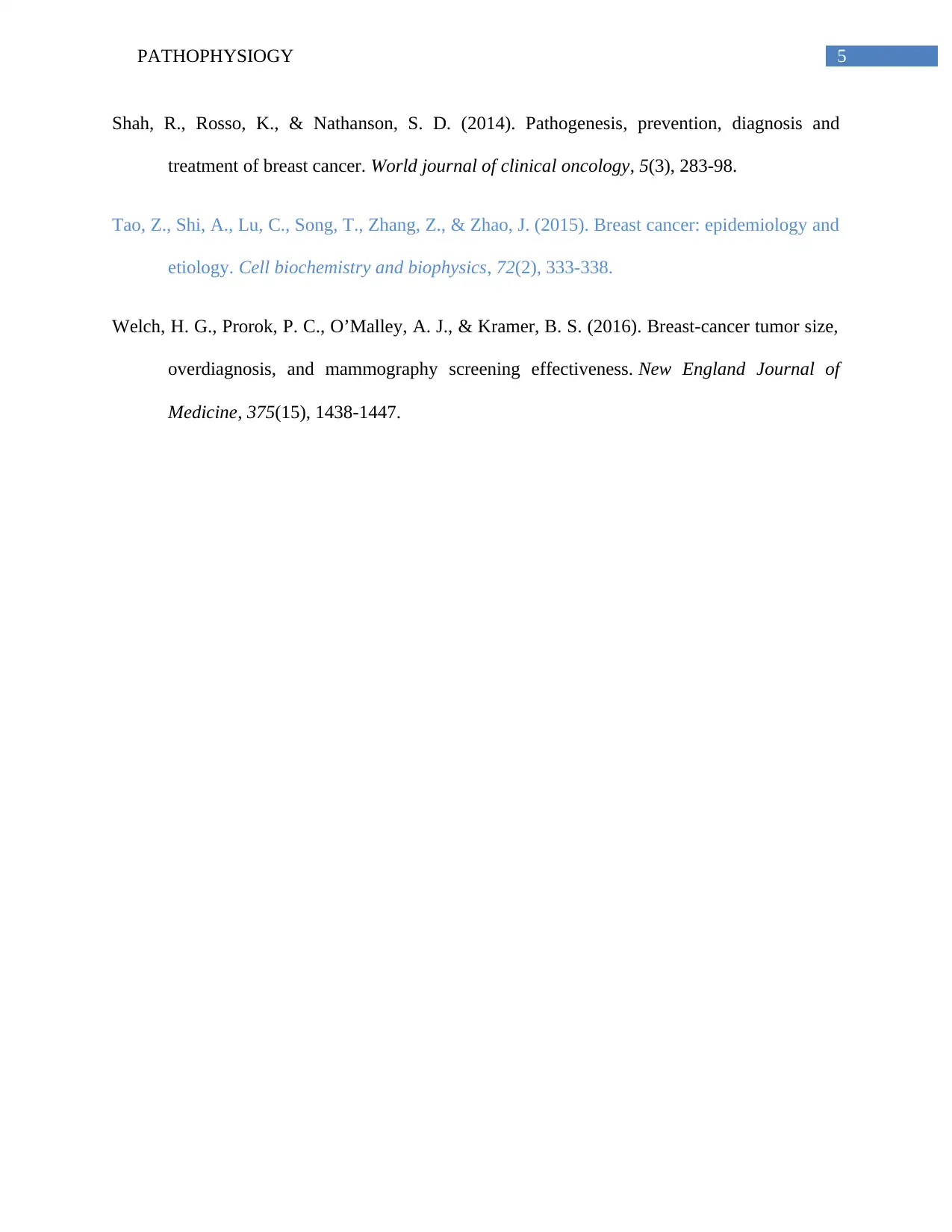Link between patient’s risk factors and the disease pathophysiology
VerifiedAdded on 2023/04/05
|6
|1070
|128
AI Summary
This article explores the link between patient’s risk factors and the pathophysiology of the disease. It discusses the impact of the disease on patient’s clinical manifestations and provides information on diagnostic investigations and treatment modalities for breast cancer.
Contribute Materials
Your contribution can guide someone’s learning journey. Share your
documents today.

Running head: PATHOPHYSIOLOGY
Pathophysiology
Name of the student:
Name of the University:
Author’s note
Pathophysiology
Name of the student:
Name of the University:
Author’s note
Secure Best Marks with AI Grader
Need help grading? Try our AI Grader for instant feedback on your assignments.

1PATHOPHYSIOGY
Link between patient’s risk factors and the disease pathophysiology:
The case scenario is about Catelyn Stark, a 50 year old premenopausal female who is
diagnosed with stage four metastatic breast cance. The risk factors found in Catelyn Stark
includes advancing age and changes in the pathophysiology of breast (Shah, Rosso &
Nathanson, 2014). She has been found with a lump on the breast and she is referred for a
lumpectomy too. Advancing age accounts for the pathophysiology of breast cancer because the
risk of the disease increases with age until menopause. 80% of all breast cancer occurs within
women above 50 years of age. The estimated risk is higher for women between 50- 70 years
compared to women before 49 years (McGuire et al., 2015). As Catelyn is 50 years old, she is
entering the age group vulnerable to breast cancer risk. In addition, Catelyn Stark was found
with a lump on the breast. The history of breast cancer and presence of any premalignant ductal
carcinoma is strongly linked to the risk of developing breast cancer as mutation of BRCA1 genes
and BRCA2 genes lead to increased cell proliferation of leptinin breast adipose tissue expansion
(Tao et al., 2015). Her lump in the breast was also accompanied by nipple discharge and this is a
risk factor because benign tumour is associated with discharge and lesion within a milk duct.
Parthasarathy and Rathnam (2012) explains that nipple discharge is an early sign of breast
cancer.
Impact of the pathophysiology of the disease on patient’s clinical manifestations:
Some of the clinical manifestation of Catelyn Stark includes painless lump in the upper
outer quadrant of her left breast, nipple discharge, moderate pitting odema on the left arm and
weight loss. These symptoms have been produced because of the pathophysiology associated
with metastatic breast cancer. Lump in the breast is a common symptom of breast cancer and this
Link between patient’s risk factors and the disease pathophysiology:
The case scenario is about Catelyn Stark, a 50 year old premenopausal female who is
diagnosed with stage four metastatic breast cance. The risk factors found in Catelyn Stark
includes advancing age and changes in the pathophysiology of breast (Shah, Rosso &
Nathanson, 2014). She has been found with a lump on the breast and she is referred for a
lumpectomy too. Advancing age accounts for the pathophysiology of breast cancer because the
risk of the disease increases with age until menopause. 80% of all breast cancer occurs within
women above 50 years of age. The estimated risk is higher for women between 50- 70 years
compared to women before 49 years (McGuire et al., 2015). As Catelyn is 50 years old, she is
entering the age group vulnerable to breast cancer risk. In addition, Catelyn Stark was found
with a lump on the breast. The history of breast cancer and presence of any premalignant ductal
carcinoma is strongly linked to the risk of developing breast cancer as mutation of BRCA1 genes
and BRCA2 genes lead to increased cell proliferation of leptinin breast adipose tissue expansion
(Tao et al., 2015). Her lump in the breast was also accompanied by nipple discharge and this is a
risk factor because benign tumour is associated with discharge and lesion within a milk duct.
Parthasarathy and Rathnam (2012) explains that nipple discharge is an early sign of breast
cancer.
Impact of the pathophysiology of the disease on patient’s clinical manifestations:
Some of the clinical manifestation of Catelyn Stark includes painless lump in the upper
outer quadrant of her left breast, nipple discharge, moderate pitting odema on the left arm and
weight loss. These symptoms have been produced because of the pathophysiology associated
with metastatic breast cancer. Lump in the breast is a common symptom of breast cancer and this

2PATHOPHYSIOGY
symptom manifest because of series of molecular alterations at the cellular level. Some
individuals are at risk because of changes in the BRCA1, BRCA2 and p53 genes (Mehrgou &
Akouchekian, 2016). The interaction between the environmental and genetic factors results in
the mutation of the genes encoding the protective RAS/MEL/ERK pathway. The abnormalities
in the growth factor may result in malignant cell growth and increased cell proliferation because
of leptinin breast adipose tissue (Shah, Rosso & Nathanson, 2014). This pathophysiological
mechanism explains the clinical manifestation of lump in Ms. Catelyn Stark.
Nipple discharge was also one of the symptoms for Catelyn Stark and this symptoms
manifest because of change in the physiology of breast due to genetic mutation of BRCA1 and
BRCA2 genes. Other changes occurring in the body includes non-pitting oedema beneath the
armpit which was found for Catelyn too. This is linked to inflammatory breast cancer where non-
cancerous tumors develop within the stroma of the breast. A breast cancer may present as
metastatic disease, the site of metastasis leads to symptoms like unexplained weight loss and
fever.
Diagnostic investigations and treatment modalities for breast cancer:
The diagnosis of breast cancer is done by screening methods like breast-self-examination,
mammography, magnetic resonance image and ultrasound (Shah, Rosso & Nathanson, 2014).
Monthly breast-self examination is recommended to become aware with the normal anatomy and
detect risk of breast cancer. Another diagnostic method is mammography which is an x-ray
picture of the chest to detect sign or symptoms of the disease. Research evidence justifies the
benefit of mammography screening by explaining the diagnostic procedure detects small
malignant tumors before they grow large enough to be seen as symptom (Welch et al., 2016).
symptom manifest because of series of molecular alterations at the cellular level. Some
individuals are at risk because of changes in the BRCA1, BRCA2 and p53 genes (Mehrgou &
Akouchekian, 2016). The interaction between the environmental and genetic factors results in
the mutation of the genes encoding the protective RAS/MEL/ERK pathway. The abnormalities
in the growth factor may result in malignant cell growth and increased cell proliferation because
of leptinin breast adipose tissue (Shah, Rosso & Nathanson, 2014). This pathophysiological
mechanism explains the clinical manifestation of lump in Ms. Catelyn Stark.
Nipple discharge was also one of the symptoms for Catelyn Stark and this symptoms
manifest because of change in the physiology of breast due to genetic mutation of BRCA1 and
BRCA2 genes. Other changes occurring in the body includes non-pitting oedema beneath the
armpit which was found for Catelyn too. This is linked to inflammatory breast cancer where non-
cancerous tumors develop within the stroma of the breast. A breast cancer may present as
metastatic disease, the site of metastasis leads to symptoms like unexplained weight loss and
fever.
Diagnostic investigations and treatment modalities for breast cancer:
The diagnosis of breast cancer is done by screening methods like breast-self-examination,
mammography, magnetic resonance image and ultrasound (Shah, Rosso & Nathanson, 2014).
Monthly breast-self examination is recommended to become aware with the normal anatomy and
detect risk of breast cancer. Another diagnostic method is mammography which is an x-ray
picture of the chest to detect sign or symptoms of the disease. Research evidence justifies the
benefit of mammography screening by explaining the diagnostic procedure detects small
malignant tumors before they grow large enough to be seen as symptom (Welch et al., 2016).

3PATHOPHYSIOGY
Hence, greater number of small tumors are detected by means of effective screening using
mammography. In addition, breast MRA and Ultrasound are also important part of breast cancer
diagnosis and management. MRIS is effective when evaluation through mammography cannot
be done because of augmentation. Ultrasound is indicated for suspected abnormalities on
mammography or MRI and those women who are at high risk and do not have access to MRI
(Mango et al., 2015).
Some of the common therapies for breast cancer patient include lumpectomy, total
mastectomy. Mastectomy or surgical removal of the entire breast is dependent on the stage of
cancer and the type of the tumor. Lumpectomy or mastectomy is usually followed by adjuvant
treatment like radiation therapy which reduces the chance of recurrence by using high energy x-
rays or gamma rays to target tumor (Kummerow et al., 2015). However, evidence by Jagsi et al.
(2016) argues that the success of reconstruction is dependent on patient factors like
comorbidities and prior surgical procedures.
Hence, greater number of small tumors are detected by means of effective screening using
mammography. In addition, breast MRA and Ultrasound are also important part of breast cancer
diagnosis and management. MRIS is effective when evaluation through mammography cannot
be done because of augmentation. Ultrasound is indicated for suspected abnormalities on
mammography or MRI and those women who are at high risk and do not have access to MRI
(Mango et al., 2015).
Some of the common therapies for breast cancer patient include lumpectomy, total
mastectomy. Mastectomy or surgical removal of the entire breast is dependent on the stage of
cancer and the type of the tumor. Lumpectomy or mastectomy is usually followed by adjuvant
treatment like radiation therapy which reduces the chance of recurrence by using high energy x-
rays or gamma rays to target tumor (Kummerow et al., 2015). However, evidence by Jagsi et al.
(2016) argues that the success of reconstruction is dependent on patient factors like
comorbidities and prior surgical procedures.
Secure Best Marks with AI Grader
Need help grading? Try our AI Grader for instant feedback on your assignments.

4PATHOPHYSIOGY
References:
Jagsi, R., Jiang, J., Momoh, A. O., Alderman, A., Giordano, S. H., Buchholz, T. A., ... & Smith,
B. D. (2016). Complications after mastectomy and immediate breast reconstruction for
breast cancer: a claims-based analysis. Annals of surgery, 263(2), 219.
Kabel, A. M., & Baali, F. H. (2015). Breast cancer: insights into risk factors, pathogenesis,
diagnosis and management. J Cancer Res Treat, 3(2), 28-33.
Kummerow, K. L., Du, L., Penson, D. F., Shyr, Y., & Hooks, M. A. (2015). Nationwide trends
in mastectomy for early-stage breast cancer. JAMA surgery, 150(1), 9-16.
Mango, V. L., Morris, E. A., Dershaw, D. D., Abramson, A., Fry, C., Moskowitz, C. S., ... &
Jochelson, M. S. (2015). Abbreviated protocol for breast MRI: are multiple sequences
needed for cancer detection?. European journal of radiology, 84(1), 65-70.
McGuire, A., Brown, J. A., Malone, C., McLaughlin, R., & Kerin, M. J. (2015). Effects of age
on the detection and management of breast cancer. Cancers, 7(2), 908-29.
doi:10.3390/cancers7020815
Mehrgou, A., & Akouchekian, M. (2016). The importance of BRCA1 and BRCA2 genes
mutations in breast cancer development. Medical journal of the Islamic Republic of
Iran, 30, 369.
Parthasarathy, V., & Rathnam, U. (2012). Nipple discharge: an early warning sign of breast
cancer. International journal of preventive medicine, 3(11), 810.
References:
Jagsi, R., Jiang, J., Momoh, A. O., Alderman, A., Giordano, S. H., Buchholz, T. A., ... & Smith,
B. D. (2016). Complications after mastectomy and immediate breast reconstruction for
breast cancer: a claims-based analysis. Annals of surgery, 263(2), 219.
Kabel, A. M., & Baali, F. H. (2015). Breast cancer: insights into risk factors, pathogenesis,
diagnosis and management. J Cancer Res Treat, 3(2), 28-33.
Kummerow, K. L., Du, L., Penson, D. F., Shyr, Y., & Hooks, M. A. (2015). Nationwide trends
in mastectomy for early-stage breast cancer. JAMA surgery, 150(1), 9-16.
Mango, V. L., Morris, E. A., Dershaw, D. D., Abramson, A., Fry, C., Moskowitz, C. S., ... &
Jochelson, M. S. (2015). Abbreviated protocol for breast MRI: are multiple sequences
needed for cancer detection?. European journal of radiology, 84(1), 65-70.
McGuire, A., Brown, J. A., Malone, C., McLaughlin, R., & Kerin, M. J. (2015). Effects of age
on the detection and management of breast cancer. Cancers, 7(2), 908-29.
doi:10.3390/cancers7020815
Mehrgou, A., & Akouchekian, M. (2016). The importance of BRCA1 and BRCA2 genes
mutations in breast cancer development. Medical journal of the Islamic Republic of
Iran, 30, 369.
Parthasarathy, V., & Rathnam, U. (2012). Nipple discharge: an early warning sign of breast
cancer. International journal of preventive medicine, 3(11), 810.

5PATHOPHYSIOGY
Shah, R., Rosso, K., & Nathanson, S. D. (2014). Pathogenesis, prevention, diagnosis and
treatment of breast cancer. World journal of clinical oncology, 5(3), 283-98.
Tao, Z., Shi, A., Lu, C., Song, T., Zhang, Z., & Zhao, J. (2015). Breast cancer: epidemiology and
etiology. Cell biochemistry and biophysics, 72(2), 333-338.
Welch, H. G., Prorok, P. C., O’Malley, A. J., & Kramer, B. S. (2016). Breast-cancer tumor size,
overdiagnosis, and mammography screening effectiveness. New England Journal of
Medicine, 375(15), 1438-1447.
Shah, R., Rosso, K., & Nathanson, S. D. (2014). Pathogenesis, prevention, diagnosis and
treatment of breast cancer. World journal of clinical oncology, 5(3), 283-98.
Tao, Z., Shi, A., Lu, C., Song, T., Zhang, Z., & Zhao, J. (2015). Breast cancer: epidemiology and
etiology. Cell biochemistry and biophysics, 72(2), 333-338.
Welch, H. G., Prorok, P. C., O’Malley, A. J., & Kramer, B. S. (2016). Breast-cancer tumor size,
overdiagnosis, and mammography screening effectiveness. New England Journal of
Medicine, 375(15), 1438-1447.
1 out of 6
Related Documents
Your All-in-One AI-Powered Toolkit for Academic Success.
+13062052269
info@desklib.com
Available 24*7 on WhatsApp / Email
![[object Object]](/_next/static/media/star-bottom.7253800d.svg)
Unlock your academic potential
© 2024 | Zucol Services PVT LTD | All rights reserved.





